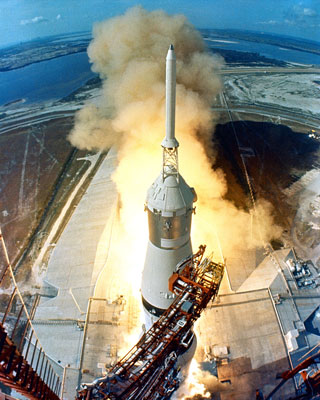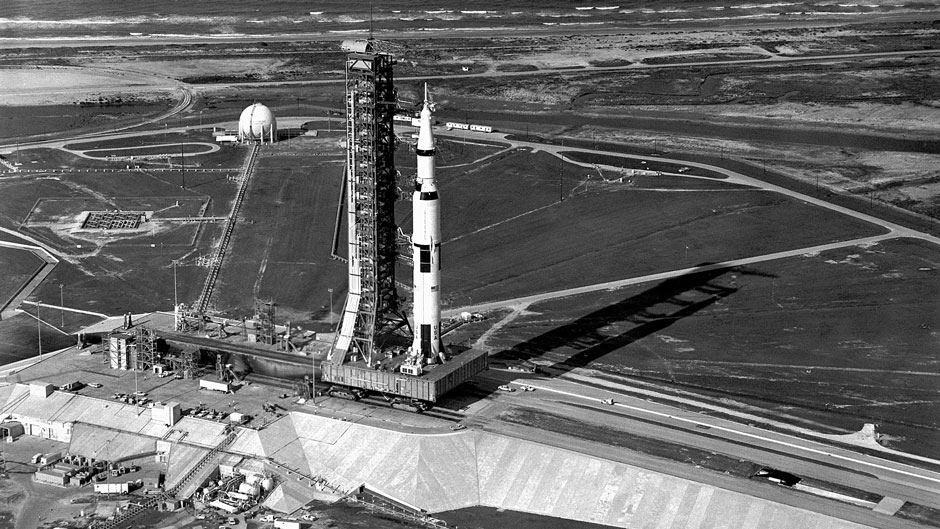The rows and rows of strip chart recorders seemed to go on forever, their long rolls of paper being expelled as more and more data was compiled.
It was just past 8 a.m. on July 16, 1969, and instrumentation engineer Frank DeMattia was sitting at a console in the back of the Launch Control Center at NASA’s Kennedy Space Center in Florida, monitoring a readout of the pressure and temperature inside the Saturn V rocket’s second stage fuel tanks.
If the readings were too high, the 21-year-old DeMattia, just five months removed from graduating with an engineering degree from the University of Miami, would have to scrub the launch.
“It was one of the mission critical systems of the rocket,” he recalled, “and it was my responsibility to call an abort if those red lines went beyond limits.”
 They didn’t. The pressure and temperature of the liquid hydrogen and liquid oxygen fuel mixture remained stable, and at 8:32 a.m. EST, the powerful Saturn V, with all other systems go, blasted off from Launch Pad 39A, sending astronauts Neil Armstrong, Buzz Aldrin, and Michael Collins on the greatest adventure in human history.
They didn’t. The pressure and temperature of the liquid hydrogen and liquid oxygen fuel mixture remained stable, and at 8:32 a.m. EST, the powerful Saturn V, with all other systems go, blasted off from Launch Pad 39A, sending astronauts Neil Armstrong, Buzz Aldrin, and Michael Collins on the greatest adventure in human history.
Today, 50 years after the Apollo 11 mission that landed the first humans on the moon, DeMattia is a consultant to the aerospace and defense industries, the many key engineering positions he held with North American Rockwell and Boeing now behind him. But one thing hasn’t changed—the modesty he exudes when describing the role he played in ensuring that Armstrong was able to take his “giant leap for mankind.”
“Twenty thousand companies and 400,000 people worked on Apollo 11. I was just a very small part of it, a cog in a very huge machine,” he said.
Still, his résumé while working on the Apollo program speaks volumes.
At UM, DeMattia was a whiz at digital electronics, the same technology built into the instrumentation system used to monitor the Saturn V rocket’s second-stage fuel tanks. “I’m sure,” he surmised, “that the folks at North American Rockwell said, ‘We’ve got this kid right out of college who knows this stuff. Let’s put him on that.’”
So just days after he left Coral Gables, the young DeMattia, who accepted a job with Rockwell over several other employment offers, found himself working on the rocket built to send people to the moon. He not only monitored the pressure and temperature inside the fuel tanks; he tested and analyzed all the instrumentation that recorded those readings.
Called a heavy lift vehicle, the multistage Saturn V was the most powerful rocket ever successfully flown. It was 363 feet tall, about the height of a 36-story building. Fully fueled, it weighed 6.2 million pounds and generated 7.6 million pounds of thrust at launch, creating more power than 85 Hoover Dams.
It was also complex. “If any one of its many, many parts failed, it would have been catastrophic,” said DeMattia. “The reason for its success, I believe, is because every single person who worked on it was absolutely committed to ensuring its quality and safety, making sure that whatever part they were responsible for worked properly.
“We knew,” DeMattia continued, “that people were going to ride on it, that people could die if the work wasn’t done right.”
Which meant that the army of engineers, scientists, technicians, and others who worked on the rocket did what was necessary to ensure the mission’s success, working seven days a week, often sleeping at the space center and going days without seeing their families.
“During the launch testing and launch sequencing, it was a 24/7 job, and if you weren’t on the base, you were on call,” recalled DeMattia. “But it was exciting. There was a lot going on. For a techie like myself, when I got up there and saw the degree of technology—the Vehicle Assembly Building where the rocket stages were stacked, the crawler that rolled the rocket out to the launch pad—it was just astounding for a kid just out of college.”
When the rocket lifted off from its launch pad and successfully achieved escape velocity, the speed at which an object must travel to break free of Earth’s gravitational force and enter orbit, the launch control room erupted in cheers, DeMattia one of the many engineers inside who felt sense of achievement.
He had arrived at the space center the night before and was understandably exhausted. But the young engineer and others inside the launch control room were unable to leave even after official control of the mission was handed over to the Mission Control Center in Houston because the traffic in and around the area was so bad.
On the day of the moon landing, DeMattia was just like everyone else, sitting in front of a television set with friends to watch Armstrong’s historic walk and praying for the mission’s success.
He worked at Kennedy Space Center for the entire Apollo program, helping to send 24 men in all to the moon.
Besides the Saturn V rocket’s second stage, DeMattia also worked on the communications systems of the Apollo spacecraft, which consisted of a combined command and service module and a lunar module.
It is nearly impossible, he said, to measure the impact of the Apollo program. “It drove the miniaturization of electronics. It drove software development and helped improve materials and management processes to a much larger scale—all of which have benefited our way of life,” said DeMattia. “We have cell phones that are smart, computers that sit on our desks, and networks that tie the world together—we have the space program to thank to some degree for all of that.”
Going back to the moon and beyond, he said, is imperative.
“At the time we did the Apollo program, we had no idea that it would result in such technology,” said DeMattia. “Now that we’re planning to return and go on to Mars, we still don’t know what we’re going to find out. But I guarantee you it’s going to be something that has a major impact on the world and on the way we live, and hopefully in a positive way.”

